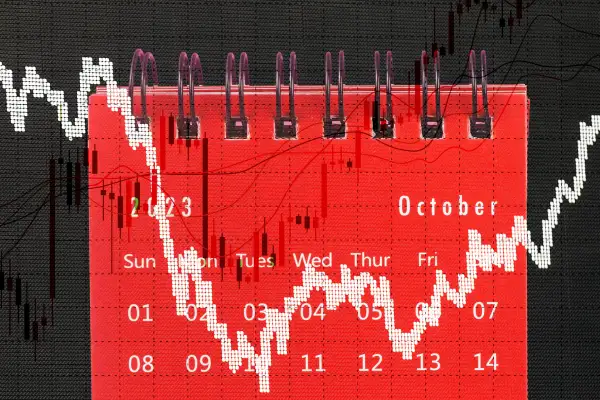The October Stock Market Stands out for High Volatility — and Above-Average Returns
Money is not a client of any investment adviser featured on this page. The information provided on this page is for educational purposes only and is not intended as investment advice. Money does not offer advisory services.

It's apt that October — a month associated with Halloween and all things horror — is one of the scariest months for the stock market. As we get into the depths of autumn and the weather gets gloomier, so too does sentiment on Wall Street.
Experienced investors may be familiar with the idea that stocks have more than their fair share of ups and downs in October. Since World War II, "the S&P 500’s average volatility in October has been 35% higher than the average for the remaining 11 months of the year," Sam Stovall, chief investment strategist at CFRA Research, tells Money.
Volatility — the tendency for something to change quickly and unpredictably — is somewhat of a bad word in the stock market. It can understandably make investors uneasy, but the truth is that volatility is not an inherently bad thing, hard as it may be to stomach in the moment.
Stock volatility and the 'October effect'
Heightened volatility in October has become a bit of an expected norm, leading to the coining of the so-called "October effect."
The October effect is a phenomenon where investors expect stocks to nosedive at some point during the month. "Historically, investors have been fearful of the stock market’s returns in October, likely because of the crashes of 1929 and 1987," Stovall says.
Those events saw many portfolios reduced to ashes. The 1987 crash saw the S&P 500 drop by 21.8% — the largest single-month decline since 1945. As a result, many American investors have come to dread the month of October.
It's an interesting oddity. But in actuality, stocks tend to perform better in October than many investors think.
Do stocks usually fall or rise in October?
"The popular notion is that performance of stocks in October is lackluster," Terry Sandven, chief equity strategist at U.S. Bank Wealth Management, tells Money. "However, over the past 20 years, from 2003 through 2022, the S&P 500 has posted gains 65% of the time."
Sandven says that in this timeframe, October sees an average S&P 500 return of 1.4%, higher than the average return of all but three other months. This exemplifies how volatility isn't always necessarily a bad thing. On one hand, October has seen two of the worst months of stock market performance in U.S. history in 1929 and 1987; on the other hand, as Sandven's figures show, the month sees a lot of positive volatility, delivering unpredictable gains for stockholders, too.
Ross Mayfield, investment strategy analyst at Baird, tells Money that in fact, "August and September tend to be more difficult for equities" than October tends to be.
CFRA Research data shows that since 1945, the month of September brings in an average loss of 0.74%, compared to October's 1.4% gain.
Of course, nobody knows how stocks will perform in any given month in the the future without a crystal ball. But stock performance in August and September is sometimes used to forecast the next months to come.
In 2023, the eighth and ninth months show promising signs of what could happen in October. "When markets are up double digits entering August, and then fall during the August to September period, the fourth quarter tends to be very strong," says Mayfield.
The S&P 500 was in fact up by almost 20% going into August 2023. That month returned a loss over about 1.3%, and September looks as though it will end with a loss of around 5%.
What to expect for stocks in October 2023
All said, don't get nervous just because October is descending on us. Stocks have shown signs of strength, entering a new bull market in June.
Recent news of potential recessions and more Federal Reserve interest rate hikes might sound glum, but plenty of analysts expect no recession in 2023. Moreover, Stovall points out that the period between the Fed's last rate hike and first rate cut could be profitable. Since 1990, the S&P 500 has grown by an average of 13% during these pause periods between the last hike and first cut.
Either way, don't panic. Timing the market is never a sound strategy. The best course of action is to keep a diversified portfolio of stocks, bonds and mutual funds that best suits whatever long-term goals you have in mind.
Volatility shouldn't be much of a concern when looking at October's history of gains, and if you're investing for the long haul, that volatility will iron itself out over time anyway.
More from Money:
3 Signs You’re Too Casual About Debt
7 Best Online Trading Platforms of 2023
Are You Putting Too Much Money in Your High-Yield Savings Account?

